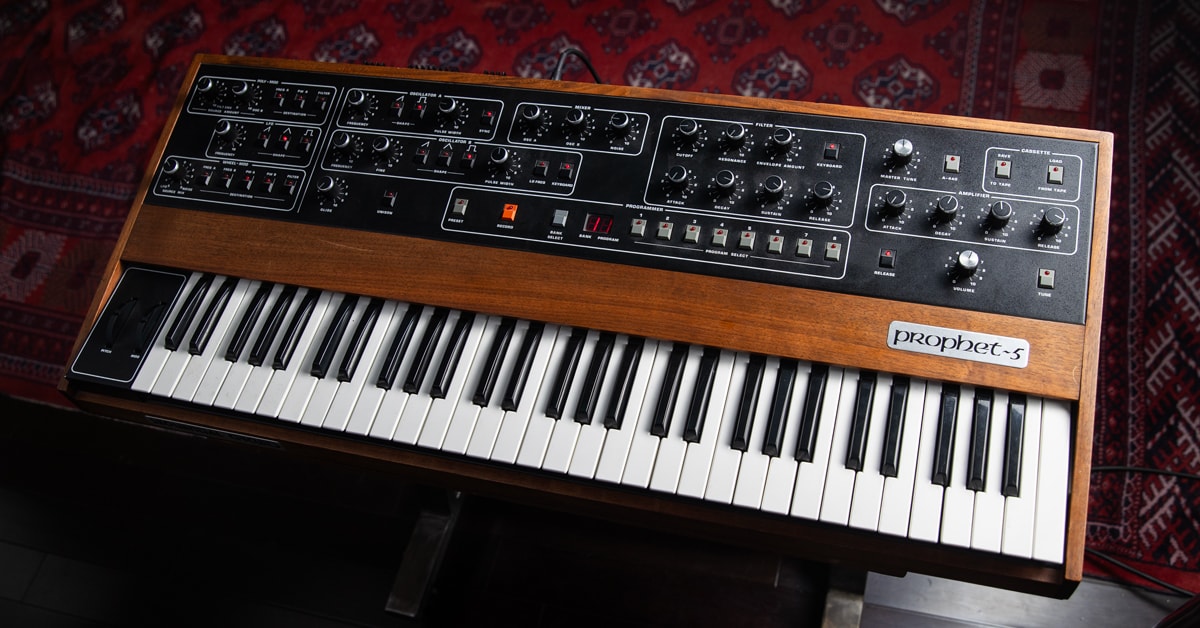Even though electronic—as opposed to electrified—musical instruments have been with us for over a century now, the modern synthesizer really started to take form in the 1960s and ’70s. There are a handful of instantly recognizable names from that frenetic period of synth development—Robert Moog, Don Buchla, Alan R. Pearlman, Tom Oberheim and Dave Smith.
Of those five, it's arguable that Sequential founder Dave Smith may just be the most influential in the long run, due in large part to his work, along with Roland's Ikutaro Kakehashi, in the development of the MIDI standard, along with his designs for the first microprocessor-controlled, polyphonic analog synth, the Prophet-5. In this article, we're going to take a quick look at the late Dave Smith's career, the history of Sequential and the Prophet series, and do a dive into the current roster of synths that bear the Prophet name.
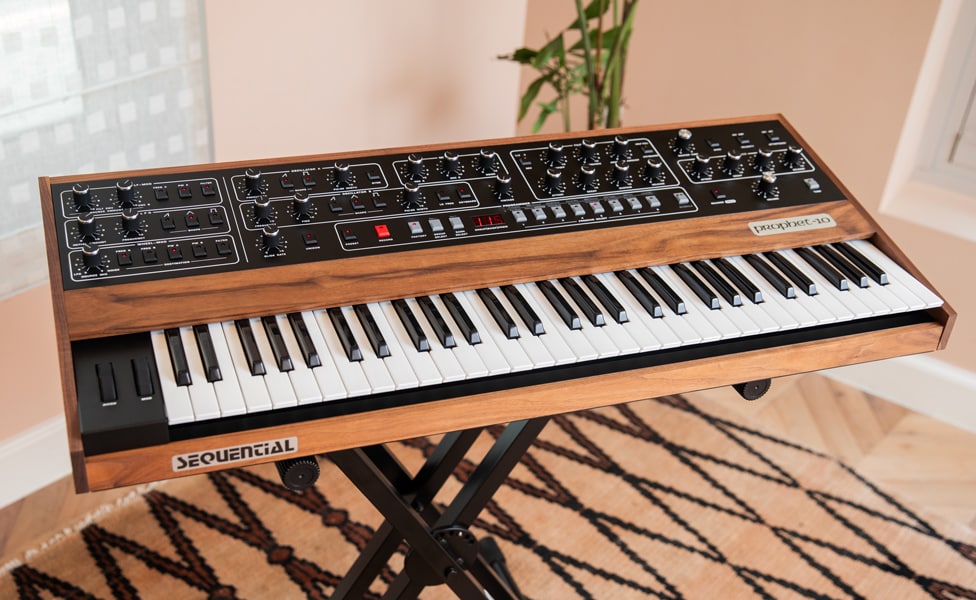
Pictured: Sequential Prophet-10 Synthesizer
If you want to bypass the history stuff and just get straight to the current product line, just click here. We won't take offense.
Table of Contents
A Brief History of Dave Smith, Sequential and the Prophet Synthesizer
The Early Years of Sequential Circuits
A Prophet Is Born
MIDI: The Standard that Shook the Synth World
The End of Sequential's First Incarnation
Out of Sequence
Dave Smith Instruments and the Return of Sequential
Today's Roster of Sequential Prophet Synths
Sequential Prophet-5/Prophet-10 Analog Synthesizers
Sequential Prophet-6 Analog Synthesizer
Sequential Prophet Rev2 Synthesizer
Sequential Prophet-X Hybrid Synthesizer
Sequential Take 5 Poly Synthesizer
Sequential Pro 3 Multi-Filter Mono Synthesizer
Finding Used and Vintage Sequential Gear
Final Modulations
A Brief History of Dave Smith, Sequential and the Prophet Synthesizer
It's not possible to overstate Dave Smith's importance and impact on the history of synthesizers. Pretty much every hardware synth since the release of the first Prophet-5 borrows user interface and control features that were pioneered on that platform. Smith's designs were a major part of taking synthesis from being largely an academic, experimental approach to being a cornerstone of modern music, across all genres. In this section we're going to take a relatively brief look—considering that entire books have been written on this, notably David Abernathy's The Prophet of Silicon Valley: A Complete History of Sequential Circuits—at some of the most important waypoints along the way.
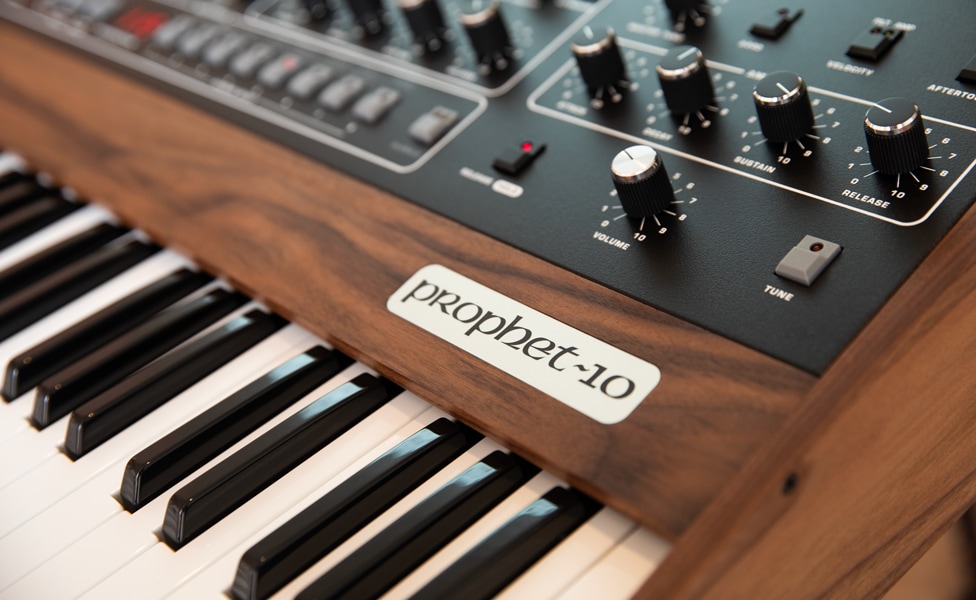
Pictured: Sequential Prophet-10 Synthesizer
Dave Smith grew up with a combined interest in music and technology, learning piano at home and later gigging with bands while pursuing degrees in electronic engineering and computer science at University of California, Berkeley. In those pre-Silicon Valley days of the early 1970s, those degrees pretty much meant you'd be working for some aerospace firm, which is where Smith ended up after graduation. But—and we can all feel fortunate for this semi-random event—a friend told him, "Hey, they've got one of these synthesizer things at a local music store."
Arriving at the store, Smith found himself staring at a Minimoog Model D. Though he admittedly didn't know anything about synths at the time, he said, "I saw a thing with lots of knobs and a keyboard, and I thought, 'I have to have that.'" The next day, he went to the company credit union and took out a loan to buy himself that Minimoog, a synth he proudly held onto over the years.
The Early Years of Sequential
Over the next couple of years, while still holding down his full-time engineering job, Smith began to build a side hustle making accessories for Moogs and other synths then on the market. He had designed and built an analog sequencer that could work with pretty much any synth that used the control voltage scheme that Bob Moog and Don Buchla had independently developed for their modular synths. It also ran fast enough to be a sound source in its own right—a unique feature. Smith figured, rightly so, that if he found it useful, others would as well.
So, he filed the paperwork to start a company that he dubbed Sequential Circuits, keeping the name a little vague, as, in those early days, he thought he might someday want to design some non-musical product. At the time, he was building what was to be named the Model 600 Sequencer and Complex Waveform Generator, in a workshop he had set up in a closet in his apartment.
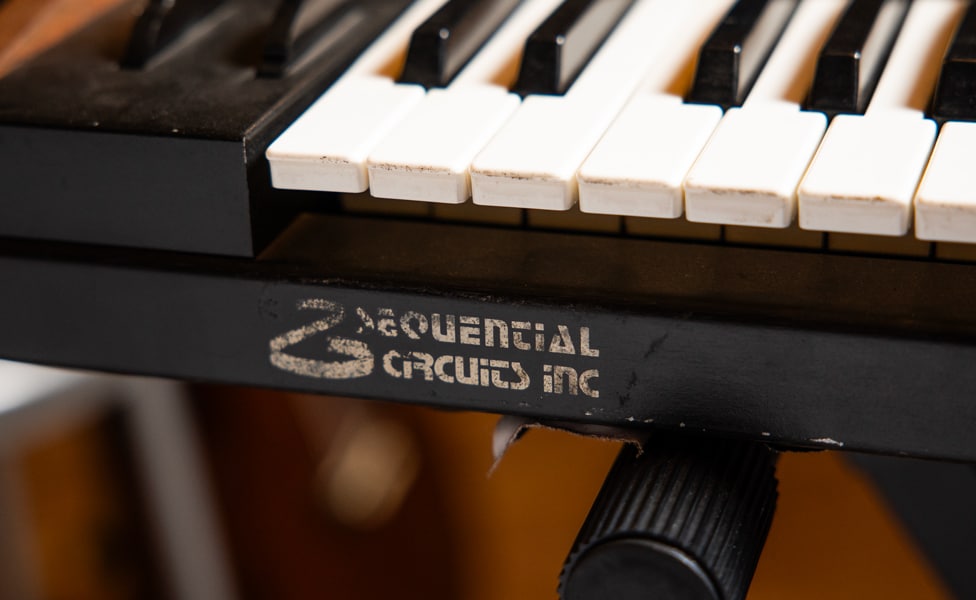
Pictured: Sequential Circuits Insignia on Prophet 600 Synthesizer
The Model 600 was soon followed by a digital sequencer, the Model 800, and a general-purpose programming unit—the Model 700 Programmer. While some specific synths had proprietary programmers, what set the Model 700 apart was that it could be used with almost any modular synth to store control voltage settings and reload them, giving those synths the ability to have a basic form of recallable presets, something they had been sadly lacking. It didn't hurt that it cost a lot less than the proprietary systems. These products sold well enough that Smith was able to quit his day job, hire a handful of employees, and move the production out of his apartment to a small commercial building.
A Prophet Is Born
At this point, Sequential had two of the three basic building blocks of a synthesizer system—a sequencer and a programmer/preset unit. Around this time, in early 1977, Smith heard about a new company, Solid State Music (SSM), which was introducing a chipset that was designed to simplify the process of analog synthesis—a voltage-controlled amplifier, oscillator and filter, or VCA, VCO and VCF, to use the usual TLAs (three-letter abbreviations).
Smith, who had been kicking around a design for a polyphonic synth since before Sequential was founded, thought to himself, "Well, this is such an obvious idea that Moog or ARP will be jumping on it." When several months passed and he had heard nothing about such development efforts, he decided to create the programmable, five-voice (because that way you could use all five fingers of one hand while using the other hand on the synth controls) polyphonic analog synth that had been in the back of his mind. The design, which was dubbed the "Model 1000," would become the product that really made Sequential Circuits' global reputation.
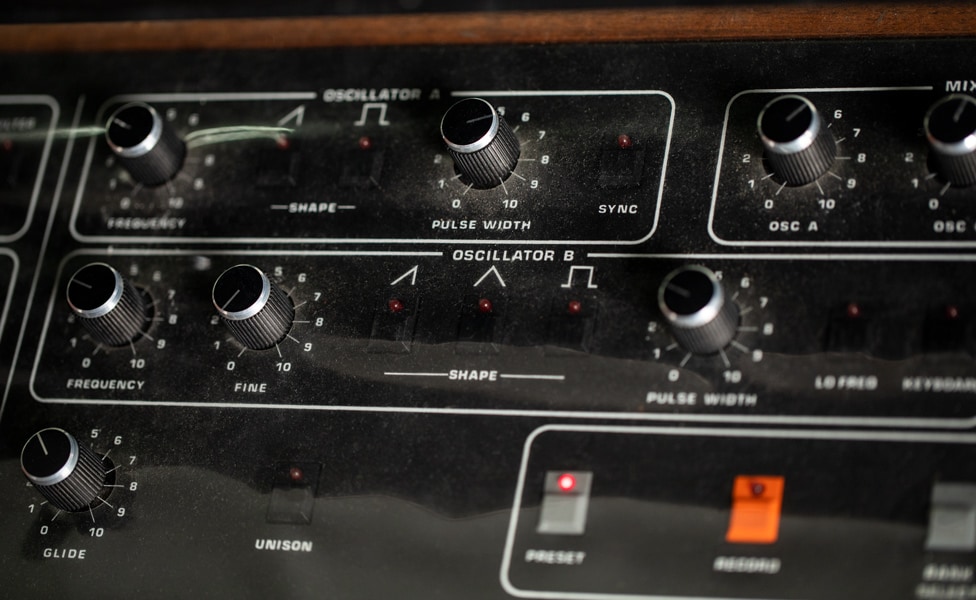
Pictured: Sequential Prophet-5 Oscillator Controls
While there were other polyphonic analog synths available at the time—for example, the Oberheim 4-Voice—the Model 1000’s design was the first to use a microprocessor to control the overall system. Since working with microprocessors had been Smith's bread and butter while he was still in aerospace, this made a huge amount of sense for the design, and would enable the circuitry to be less complex, more compact and (relatively) affordable.
The Model 1000 project was putatively a secret, happening in a separate area at Sequential from the assembly of the existing products, with the incredibly ambitious goal of having the design completed and ready to show at the January 1978 NAMM show. Along the way, Yes keyboardist Rick Wakeman—who was using the sequencer and programmer—stopped by the Sequential shop when the band was playing in San Francisco, and Smith showed him some preliminary drawings of the Model 1000. Wakeman's sole comment (at least that we know of) was, “Don't give it a number, give it a name.” And so it was that the Model 1000 became the Prophet-5.
One thing to bear in mind about Sequential Circuits is that it was a very young company, both in commercial existence and in the age of its employee base and ownership.
Andrew McGowan, an early Sequential employee, who was there from practically the beginning (and who would be the first person Dave Smith brought back after starting Dave Smith Instruments in 2002—more about that later), recalls, “It was amazing. The average age was probably 23 or 24 or something like that. There were a couple of older employees, but there were people as young as—there was a guy that worked in electromechanical assembly that rode in on his BMX bike after high school every day. There were teenagers there. And it was only kind of in retrospect that I thought about how much we didn’t know.”
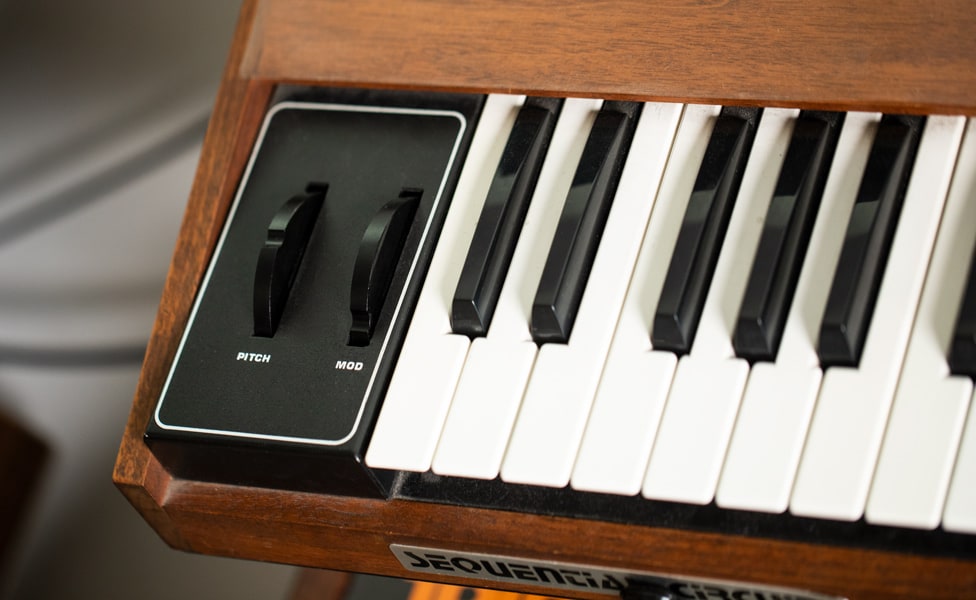
Pictured: Sequential Prophet-5 Pitch and Mod Wheels
Dave Smith himself has admitted that much of the development of the Prophet-5 was a learning experience for him. The miracle of it is that 27-year-old Smith was able to complete designing and prototyping the Prophet-5 in about six months, and was able to show up at the NAMM show—after having worked all the previous night ironing out some last-minute bugs—with a (mostly) working prototype that could do things that no previous analog synth had been able to pull off.
The Prophet was compact, it was easy to use and program, and, most importantly, it sounded amazingly fat and punchy, able to do both pure synthesis and, with some judicious programming, basic instrument emulation. Plus, and this was a big plus, it had presets—user-programmable presets. The reaction was immediate and positive. The Prophet-5 was a huge hit, and the Sequential team returned home with the daunting task of gearing up production for the volume of orders they'd received.
Over the next couple of years, the Prophet-5 would advance from Rev 1 to Rev 3, adding some new features, like improved oscillator tuning, a cassette interface for storing presets and engineering changes to improve reliability. In one case, going from Rev 2 to Rev 3, they changed from the SSM chip set to one from Curtis Electromusic. Allegedly, the switch was made because tuning was more stable with the CEM chip.
As always with this kind of change, sides get drawn among players, and you'll find ongoing discussions about the merits of the Rev 1 and Rev 2 Prophet-5 vs. the Rev 3. If you get interested in collecting vintage analog synths (which we'll touch on later), you, too, can be part of the fun.
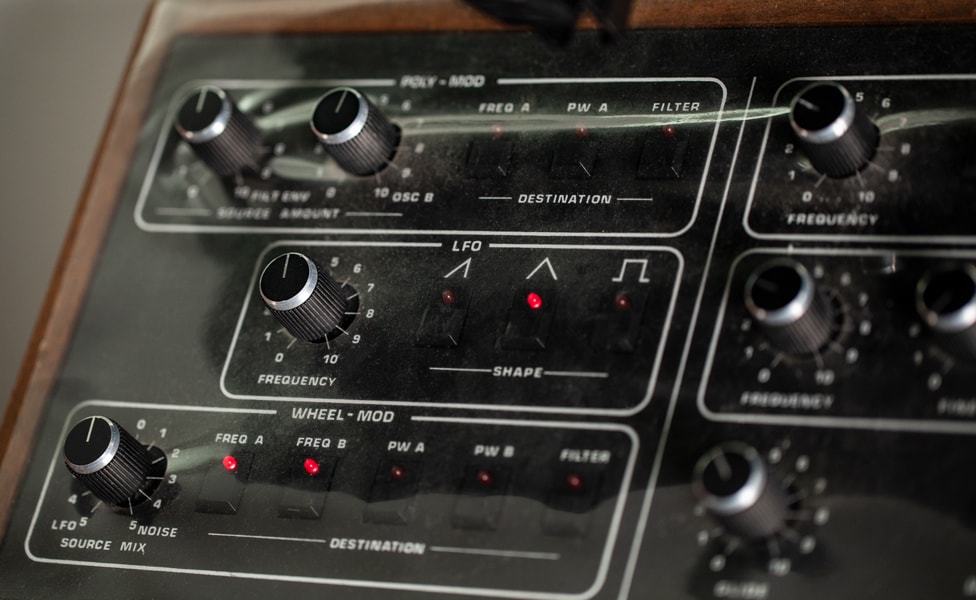
Pictured: Sequential Prophet-5 LFO Controls
The big changes in Rev 3, specifically in Rev 3.3, which would be the last version of the original Prophet-5, were expanding the preset memory to 120 presets from the previous 40, and the addition of a new thing that would soon be taking the synth world by storm—the Musical Instrument Digital Interface or, as we better know it, MIDI.
MIDI: The Standard that Shook the Synth World
Dave Smith's involvement in conceiving and working on development of the MIDI standard in the early 1980s may, in the long run, stand out as the most influential work he did. Considering that almost every synth around today owes a great deal to the physical layout, programmability and user interface that Smith developed for the Prophet-5, that's saying a great deal. But MIDI was, in many ways, what made the modern universe of electronic music possible.
The ability for every MIDI-equipped instrument to communicate with any other one enabled musicians to tie together an entire performing system, regardless of who made which parts. As the standard spread beyond keyboards to other musical gear—and even to things like lighting consoles—it enabled the automation, using sequencing, of an entire show, all driven by a relatively simply control system.
Even though we're primarily here to talk about the Prophet series of synths, we feel a short tribute to the development of the MIDI standard is only proper. After all, it was largely the vision and drive of Dave Smith, in tandem with Ikutaro Kakehasi of Roland providing a push on the other side of the Pacific, that made it happen.
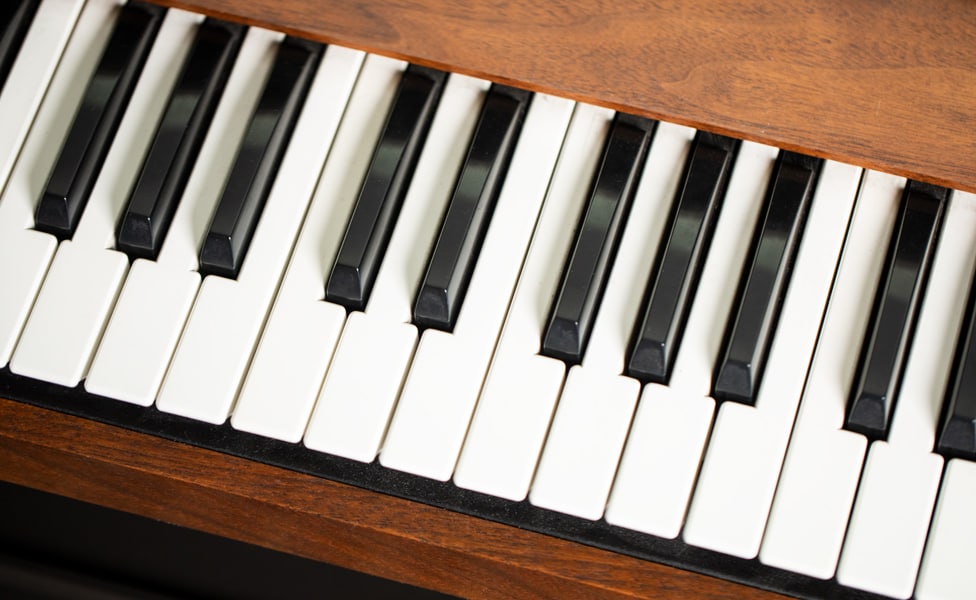
Pictured: Sequential Prophet-5 Keybed
Initially, many of the other American manufacturers were skeptical, but in Japan, where the memory of the Sony/JVC Beta/VHS wars were all too recent, the need for a standard was recognized, and Roland, Yamaha, Kawai and KORG were all on board with the idea.
Between October 1981, when Smith presented a white paper on the possibility of a universal interface at an Audio Engineering Society (AES) convention, and the NAMM show in January 1983, the standard was developed, tested and refined. When the first two keyboards sporting the now familiar 5-pin DIN jack—the Roland Jupiter 6 and the Sequential Prophet-600—were connected with a single cable and simply worked, other manufacturers began to see the wisdom of opening up to interoperability.
Meanwhile, in the synth world, things were changing rapidly.
The End of Sequential's First Incarnation
Up to this point in time (1983), analog synths had ruled the roost, especially in the world of touring keyboardists who needed compact, reasonably affordable, great-sounding synths.
While there were some early digital synths and sampling systems out there, like New England Digital's Synclavier system, the PPG Wave and the Fairlight CMI, they were large, heavy, expensive and not conducive to the touring life. All that changed with the release of Yamaha's 16-voice DX-7 FM-synthesis keyboard later that year, and the development of affordable samplers from Emu and Ensoniq. Suddenly, players were flocking to these new devices that could give them the familiar sounds they were looking for—drawbar organ, Rhodes-style electric piano and the like.
Cost was also an issue. Other analog polyphonic synths were a fraction of the cost of the Prophet, and the new digital synths were even more affordable. As a result, analog synths were losing favor as players' principal instruments, though many players were using MIDI to layer in the analog warmth missing from the more brittle (some said sterile) sound of the simple four-operator FM synthesis that the DX7 provided.
Even the new Prophet-600, which had been designed as a scaled-down, more-affordable Prophet, was languishing. Sequential, and Smith, were facing some difficult decisions about what their next step should be.
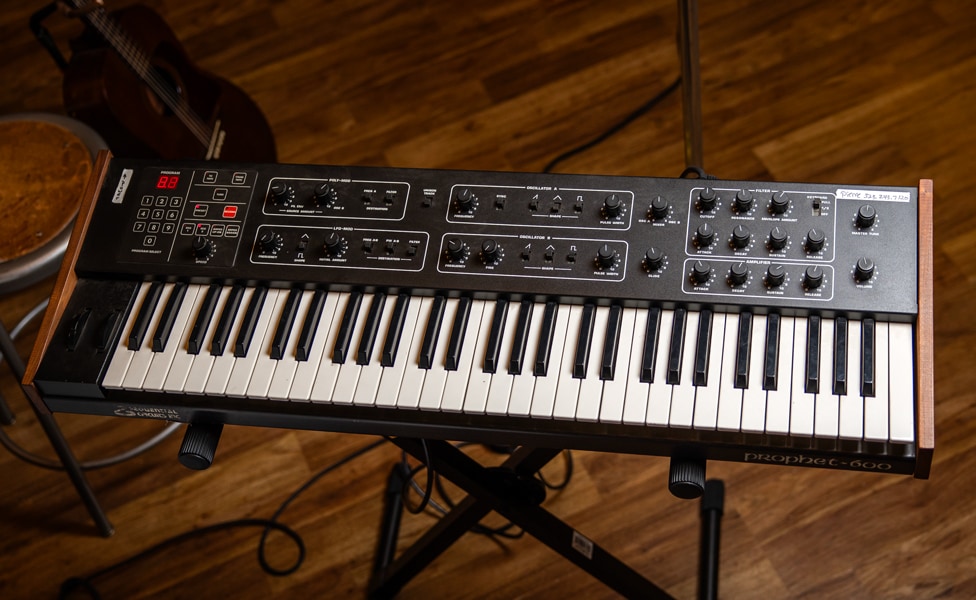
Pictured: Sequential Circuits Prophet 600 Synthesizer
There would be three more synths bearing the Prophet name released before the company was purchased by Yamaha in late 1987. The Prophet 2000 was a sample-based synthesizer. The Prophet VS debuted the concept of vector synthesis, another Dave Smith innovation, in which a joystick is used to blend four different waveforms in varying proportions. This allows complex and dynamically evolving audio textures to be created, and would be adopted by Yamaha in the SY-22 and TG-33 synths, then later in the KORG Wavestation, about which more is to come.
There was also the Prophet 3000, which was intended to be a high-end sampling workstation, but only ever shipped about 50 units.
Both of the sample-based synths and the Prophet VS were well reviewed and gained some interest, but not enough to keep the company afloat and independent. In November of 1987, Sequential Circuits was purchased by Yamaha and—for the moment, at least—ceased to exist
Out of Sequence
After Sequential Circuits was integrated into Yamaha, Smith spent some time working with Yamaha and KORG, primarily on the development of the groundbreaking KORG Wavestation, which was released in 1990. The Wavestation expanded on the vector synthesis Smith had developed for the Prophet VS, enabling crossfading between as many as 256 waveforms.
It also featured a new form of wavetable synthesis called “wave sequencing,” where any of the waveforms stored in the unit could be called and combined, looped, reversed and stitched together to create a new, endlessly shifting waveform. The two methods combined were incredibly powerful, and could create new sounds of amazing complexity.
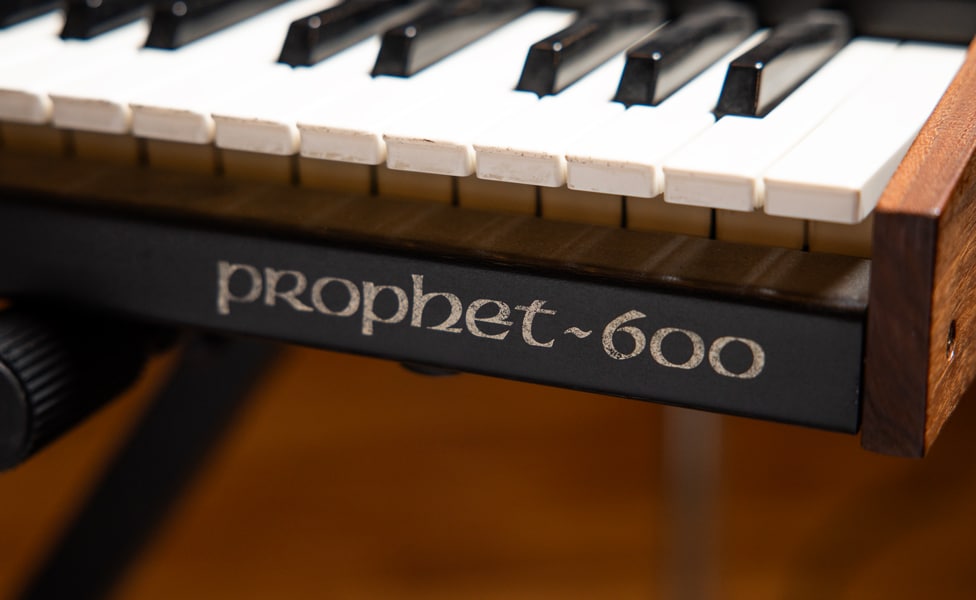
Pictured: Sequential Circuits Prophet 600 Synthesizer
The initial version of the Wavestation was designed as a synthesizer only, with no samples of “real” instruments. It included almost all the waveforms from the original Prophet VS. The Wavestation was a success, but Smith, always one to follow his own vision, soon joined former Sequential documentation manager, Stanley Jungleib, at the newly founded Seer Systems.
Seer Systems was where Smith was involved in the creation of the world's first commercially available software synthesizer, Reality. Not just a software synth, but an analog synthesis emulator, Reality was able to recreate the huge, fat analog sounds that Smith loved. But, after a handful of years at Seer, Smith decided that, as he would put it in later interviews, software synths were “no fun,” and left the company. It was not long afterward that Smith founded Dave Smith Instruments (DSI).
Dave Smith Instruments and the Return of Sequential
One of Sequential Circuits' strengths had always been Smith's vision, both as an engineer and as a musician. His desire was always to have fun making the instruments that he wanted to play. Sequential, from the start, had been an engineering-driven company, and Smith intended for Dave Smith Instruments to be the same, building what he liked and what he wanted to build.
As Andrew McGowan, Sequential veteran and the first employee at DSI, put it, “He [Smith] would say all the time, ‘I never wanted employees.’—and part of that is just that he didn’t want to be a manager. But the other thing was that he wanted to avoid what happened with Sequential. The likelihood of that happening was pretty slim, because the Prophet-5 was probably the best and worst thing that ever happened to Sequential. It went overnight really from being this tiny little company that made synthesizer accessories to having the must-have synthesizer. And the infrastructure wasn't there to build them quickly enough and get them out the door, with the cash flow happening so the company could continue.
“Dave had no interest in repeating that. He was fine keeping it small. He said everything's going to be self-financed. If we can't afford to do something, we're not going to do it. And yeah, it was really all just about building something that could keep going forward. It was very mom and pop. My wife, Joanne, was employee number two. It was small, very comfortable, also stressful at times just because there was a lot of work to do for not very many people. Very, very different from Sequential Circuits.”
While operating solely by himself as DSI, Smith first designed and released the Evolver, a monophonic digital/analog hybrid desktop module that brought together many of the best ideas from Sequential products, but with some new twists (like a stereo output on a monophonic synth). Next up was the Prophet '08 and desktop modules that were based on updated versions of the Prophet 8 synth engine—the monophonic Mopho and the four-voice Tetra.There was also the Tempest, an analog synth-based drum machine he co-designed with old friend Roger Linn. To learn more about Linn's pioneering creations, check out our article on the legacy of LinnDrum.
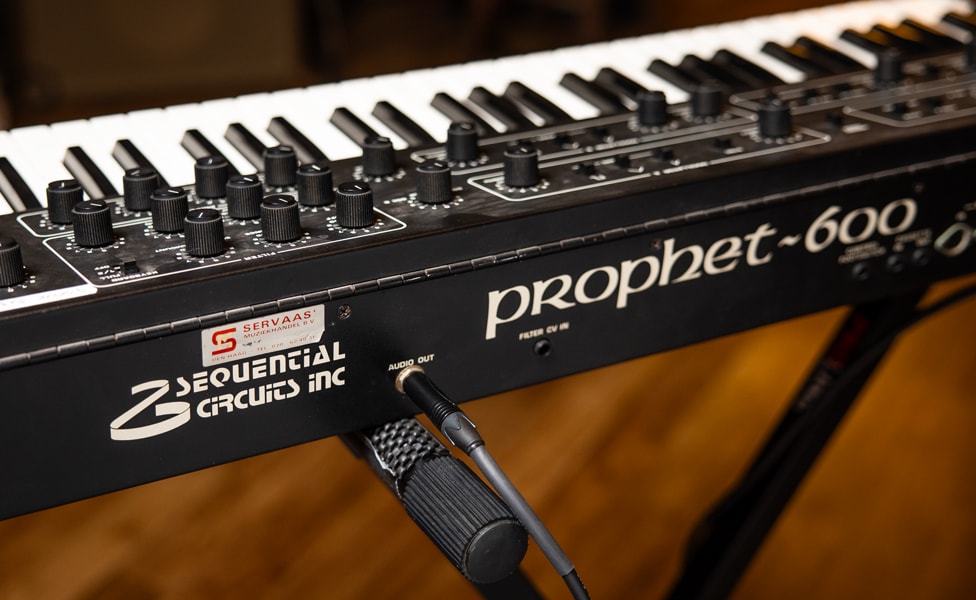
Pictured: Sequential Circuits Prophet 600 Synthesizer
But all along the way, people were requesting a reissue of the legendary Prophet-5. Smith resisted. Once again, from Andrew McGowan, “He [Smith] was one of the least nostalgic people ever, and was just not interested in revisiting or repeating past glories. By the time we got to the final stages of a product—where it was just wrapping up all the deliverables, getting everything off to the manufacturer and get it built—he was already chomping at the bit to do whatever the next thing was. Once a product was shipping, he was kind of done with it, and he was ready to do the next thing.”
Smith had begun working on a new version of the Prophet series that would become the Prophet-6. This was an update of the Prophet analog synthesis, with redesigned analog circuits and expanded digital features like built-in digital effects.
While this synth was being designed, Smith and Roland founder Ikutaro Kakehashi were awarded a Grammy for their key roles in the development of the MIDI standard. As a result of this, Ikutaro went to Yamaha and said, in effect, “You currently own the name ‘Sequential Circuits’ and aren't using it. It would be very nice if you were to return the name to the man who created it."
So, Smith was able to release the Prophet-6 under the Sequential name, the circle healed itself, and all was right with the world.
More Prophets were to follow, and Smith's legacy as a moving force and innovator in the popularization of synthesis, the evolution of analog synths, and the integration of the best of analog and digital synthesis is one that will continue to be celebrated, long after his untimely death in May of 2022. So, let's turn to that legacy in more concrete form with a look at the essential members of the Prophet family that are available today.
Today's Roster of Sequential Prophet Synths
Unlike a number of the other early synth pioneers, Dave Smith was both an engineer and a musician, having grown up playing piano and gigging as both a guitarist and bassist, even while getting his degrees in computer science and electronic engineering from University of California, Berkeley. This experience helped inform his approach to synth design, as he was often quoted as saying that he was only interested in having fun designing instruments that he would want to play.
Sequential has a full range of Prophet synths currently available, from an updated version of the original Prophet-5 to the hybrid analog/digital Prophet X. In this section, we're going to break down what's what, and help you figure out which Prophet can lead you to the light.
Sequential Circuits Prophet-5/Prophet-10 Analog Synthesizers
We're lumping the current versions of the Prophet-5 and Prophet-10 together here, because they are essentially the same synth, simply having a choice of available polyphony. Both are available as keyboard synths, or in a desktop module version of the five-voice or 10-voice versions.
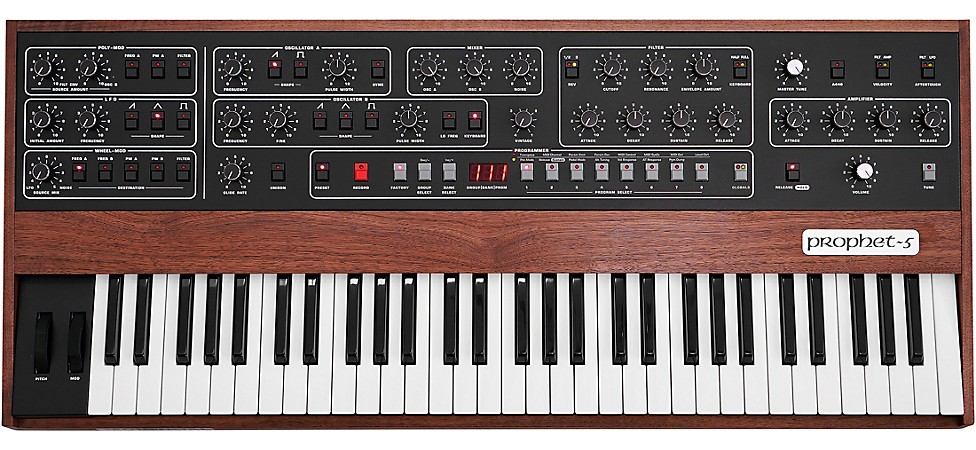
Pictured: Sequential Prophet-5 Analog Synthesizer
When Dave Smith finally decided that a reissue of the synth that started it all for Sequential Circuits was the thing to do, he would not be satisfied with simply repeating himself. The contemporary version of the Prophet-5/10 is more than just a recreation of the original. It encompasses all the different circuit revisions that Prophet went through over the years, with the ability to switch between the original filter section (designed by Dave Rossum from Emu) and the later Curtis filter. There's also a unique "Vintage" knob, which loosens up the accuracy of the oscillator, envelope and filter sections from the tight accuracy of the Rev 4 circuitry to the glorious random variation of the rare Rev 1 Prophet.
Other modern additions include velocity sensitivity and polyphonic aftertouch, for even more control of those gloriously rich analog sounds.
Bottom Line: If you lust for the rich tonality of an original Prophet-5, only more stable and flexible, this is where you need to go.
Sequential Prophet-6 Analog Synthesizer
Before Smith created the Prophet-5 reissue, he created the Prophet-6, the first synth debuting under the reborn Sequential Circuits name. As Smith said at the time, “The Prophet-6 is not a reissue or recreation of the Prophet-5, but a reimagining.” With six-voice polyphony and a plethora of updated features, plus some new twists, the Prophet-6, available in both keyboard and desktop module versions, is a great entry point if you're interested in getting hands on with modern analog synthesis.
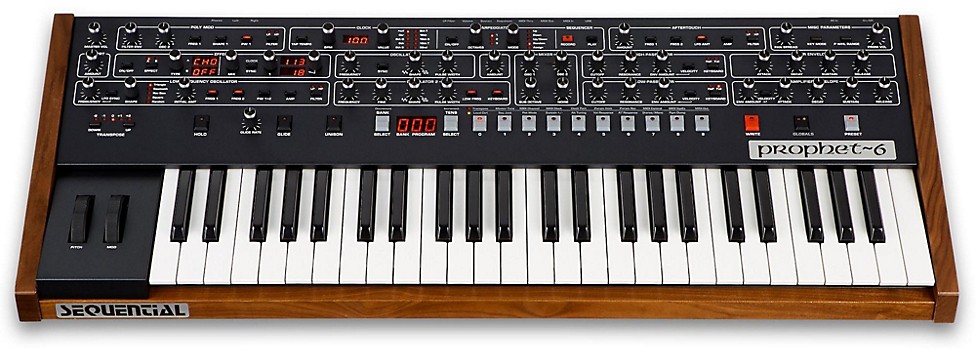
Pictured: Sequential Prophet-6 Analog Synthesizer
So, what sets the Prophet-6 apart? Of course, it has a pure analog signal path available to bring out the best of the classic, lush sound of analog oscillators, filters and envelopes. But there are a few new twists, even in the analog world. The VCO, VCF and VCA are discrete components, increasing stability, and the addition of an independent two-pole high-pass filter to the original four-pole low-pass filter expands tonal possibilities from trimming out some rumble to using the low- and high-pass filters together for band-pass effects. There's also an all-analog distortion effect and a “Slop” knob to add some randomness to the operations of the analog components.
On the digital side, there's a full 24-bit/48kHz stereo effects section that can be fully bypassed when you want to keep your signal in the analog world, a polyphonic sequencer and a powerful arpeggiator. The four-octave keyboard has also been updated with velocity and aftertouch.
Bottom Line: If you want the sound of analog, but with a few more modern touches, and aren't looking for an exact clone of the original Prophet-5, the Prophet-6 will fill the bill.
Sequential Prophet Rev2 Synthesizer
Like the Prophet-5 and Prophet-6, the Sequential Circuits Prophet Rev2 is available in both keyboard and desktop versions. The Rev2 is a reimagining of the earlier Prophet '08, with double the polyphony (16-voices) and a uniquely powerful modulation system.
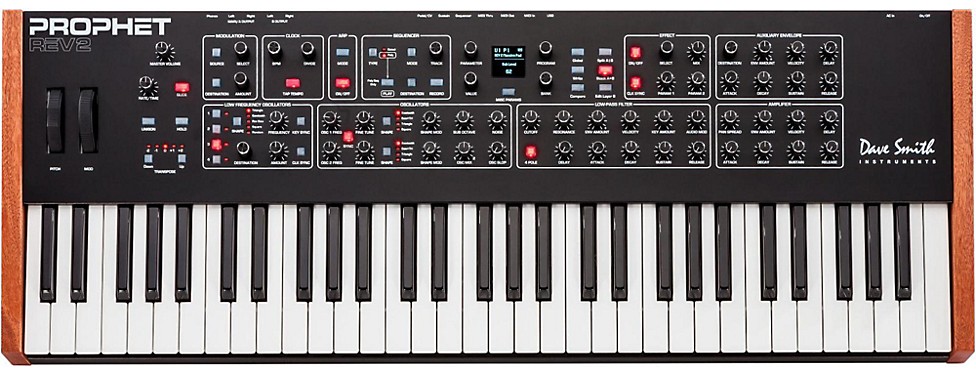
Pictured: Sequential Prophet Rev2 Synthesizer
Utilizing digitally controlled oscillators (DCOs) rather than VCOs, the Rev2 offers a huge amount of flexibility. The 16-voices easily enable splits and rich, bi-timbral layers with full control, and the modulation matrix offers up eight slots, 22 sources and 52 destinations, in addition to the pre-defined routings available from the control panel. All in all, this is an incredibly rich and powerful synth.
Bottom Line: If you love the sound of analog synthesis and want maximum flexibility, you'll want to spend some time with the Sequential Circuits Prophet Rev2.
Sequential Prophet-X Hybrid Synthesizer
The Sequential Prophet X is Sequential's entry into the world of hybrid synthesis. This incredibly powerful instrument brings together the best of digital, analog and sample-based synthesis, with 16 total voices and up to 32-note polyphony.
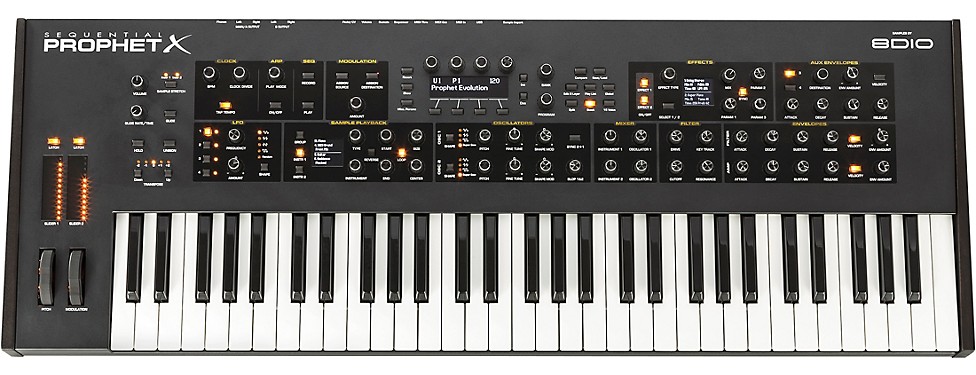
Pictured: Sequential Prophet-X Hybrid Synthesizer
The Prophet X is way more than simply the sum of its parts, though. A full range of filters, effects and modulation options allow you to take any sound, from pure analog creations to one of the internal samples (whether from the 8Dio-created sample library or one you've created yourself), and twist, tweak or rip it apart to find the new sound that's a perfect expression of your creativity. There are dual sample engines to enable layering and modulating samples together, plus powerful analog filters that will inspire you to move past the ordinary. The Prophet X can be simply a sample player, if that's what you want, but it steps far beyond that, to the limits of your sonic imagination.
Botton Line: If your vision of synthesis is broad and all-encompassing, and you want a tool that puts your imagination first, the Prophet X can take you there. Note: At press time, we learned the Prophet X was discontinued, so if you want one, act soon while supplies last.
Sequential Take 5 Poly Synthesizer
The Sequential Take 5 offers the most affordable way to experience a VCO/VCF polysynth based on the Prophet-5. The Take 5 is a subtractive synthesizer that features two VCOs, one sub oscillator per voice, a four-pole analog filter, 44 full-size keys, premium Fatar keybed, dual digital effects, dedicated overdrive and a savvy key-split option that divides the keyboard into two separate zones.
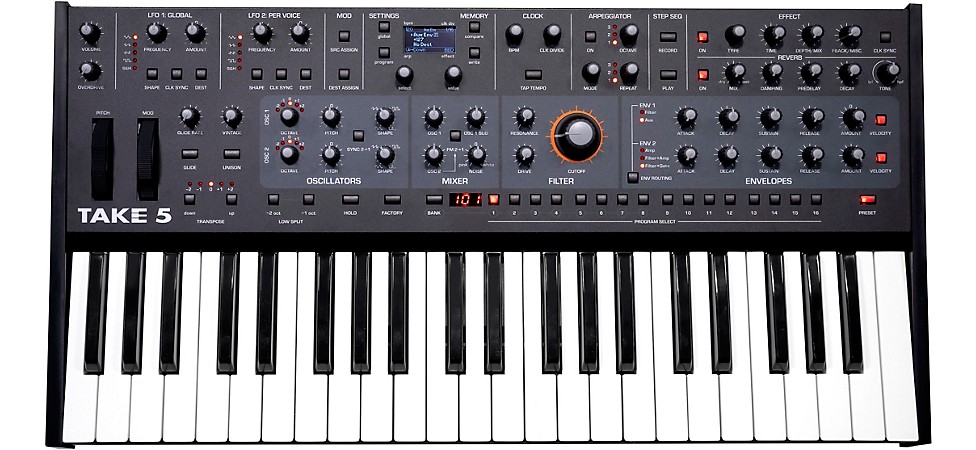
Pictured: Sequential Take 5 Poly Synthesizer
Bottom Line: If price and/or complexity has kept you from making music using subtractive synthesis—or availing yourself of classic Sequential synth sounds—the Take 5 is your “golden ticket” to an expansive creative journey.
Sequential Pro 3 Multi-Filter Mono Synthesizer
Offering a cavalcade of potent “trios,” the Sequential Pro 3 features three oscillators, three vintages filters and three LFOs. But there are even more highlights to inspire you—four loopable envelopes, 32-slot modulation matrix, 16-step sequencer, arpeggiator, dual digital effects, the ability to interface with modular synths via control voltage I/O and a three-octave, semi-weighted keyboard.
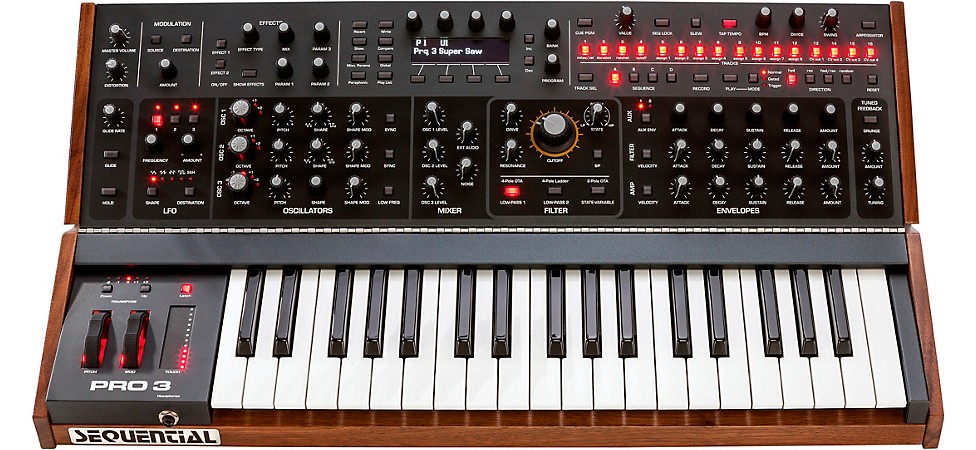
Pictured: Sequential Pro 3 Multi-Filter Mono Synthesizer Special Edition
Bottom Line: The most powerful voice-path Sequential has ever produced.
Finding Used and Vintage Sequential Gear
If reading all of this has you pining for some vintage analog synths, you can always check out our constantly changing selection of used synths and sound modules. But we'll offer up a word of warning before you dive in. Vintage analog synth gear can be tricky to use and to maintain. Some of the designs, especially earlier ones, may have components that have drifted in value over time, and may need some serious work to get back into playable form. They're definitely worth owning, and can still create great music, but they can be temperamental and more fragile than modern gear. Also, parts can be hard (sometimes almost impossible) to find, should the unit need service. We encourage the exploration and experimentation, but suggest that, like restoring a classic car or adopting a rescue dog, owning vintage gear is a responsibility not to be taken on lightly.
Final Modulations
Sequential Circuits and Dave Smith's part in the development and evolution of modern synthesis are certainly not to be denied. Smith was also someone who was humble, soft-spoken and open to the ideas of others, whether they were friends, competitors or both (witness his work on developing products with both Tom Oberheim and Roger Linn, as well as his early collaborations with Emu and others). We're glad to have been able to offer up this appreciation of both him and the products he created for us to play with.
We'd also like to add that there's no real substitute for getting hands on with these synths, and exploring just how much sonic territory they can cover. So, please, if you've got a local Guitar Center store, drop in, talk to our associates and play some of these synths to see which ones you connect with. If you don't have a local store, the Gear Advisers at our call center are equally knowledgeable and want to share that knowledge to help you make an informed decision. We look forward to hearing what y'all create.




